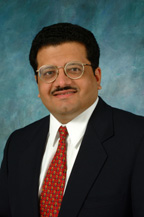 Sanjay Singh, M.D., is fascinated by the brain’s cortex, the gray matter that makes individuals uniquely human.
Sanjay Singh, M.D., is fascinated by the brain’s cortex, the gray matter that makes individuals uniquely human.
“A person lives in his cortex,” said Dr. Singh, the state’s first trained epileptologist. “It’s where they think from, it’s where their personality and emotions reside and it’s also the area that gives rise to epilepsy.”
Even so, Dr. Singh, assistant professor in UNMC’s Department of Neurological Sciences, sees it as a reservoir for hope and encouragement. For that unwavering commitment to improving the lives of epilepsy patients, Dr. Singh has received the Chancellor’s Gold ‘U’ Award for September.
“(Dr. Singh) has given, I am sure, to all of his other patients, the same as he has given Heather…hope, a new lease on life and a future that they thought they would never have,” said one nominator, whose 21-year-old daughter has battled epilepsy since 18 months of age. “I truly believe that Dr. Singh is her special angel in human form.”
|
|
The nomination letter moves Dr. Singh, although he says it is “a team effort,” as nearly 25 people work in The Nebraska Epilepsy Center, which he directs. Founded two years ago, it is the only comprehensive center in Nebraska, western Iowa and South Dakota that treats epilepsy patients, educates physicians and the public, and does research.
As a result, patients — more than 700 — come from near and far. “There was a great need,” Dr. Singh said. “When we started we thought we’d slowly build it up, but the flood gates opened.”
Sometimes called a seizure disorder, epilepsy is a chronic medical condition produced by temporary changes in the electrical function of the brain, causing seizures that affect awareness, movement or sensation.
In Nebraska, there are 20,000 to 25,000 people with epilepsy, he said. Of those, 6,000 to 8,000 have intractable epilepsy, which requires specialized care at a comprehensive center.
Beyond treating patients, Dr. Singh does educational visits across the country and hopes to begin a two-year fellowship program to train epileptologists. Approximately 35 epileptologists are certified each year, mainly on the Coasts, he said. The center also is engaged in multi-center studies to advance research in epilepsy.
“This is the time to be in this field,” he said. “I’d be very satisfied if my legacy were to improve the care of epilepsy patients in this region.”
A native of India, Dr. Singh received his medical degree from M.L.N Medical College in Allahabad, India, in 1992. He was valedictorian of his medical school class. The son of a head and neck surgeon, Dr. Singh did his neurology residency at George Washington University in Washington, D.C., where he was chief resident, and his fellowship in epilepsy and clinical neurophysiology at Yale University in New Haven, Conn.
UNMC’s Neurological Sciences Chairman Pierre Fayad, M.D., who also hails from Yale, lured Dr. Singh to Nebraska. “Omaha’s a well-hidden secret,” Dr. Singh said. “This was an opportunity to build my own epilepsy program and see patients’ lives improve.”
Fortunately, there has been a boom in treatment options in the past decade, Dr. Singh said. Today, there are 12 drugs on the market, as opposed to four a decade ago. There also are new surgical techniques, brain stimulation techniques and new drugs in the clinical trial stage. “We’ve learned much more about the brain in the past five years than we have in the past 500 years,” he said.
Beyond building one of the region’s premier epilepsy centers, Dr. Singh enjoys cricket, basketball and soccer; reading nonfiction; following current affairs; and spending time with his wife, Vandana, and young daughter, Yutika.
Epilepsy does not discriminate, he said. His patients range in age from 17 to 98. One to two in 100 will have seizures. Still, “just because you have epilepsy doesn’t mean you can’t live your life normally,” he said.
In addition to his medical expertise, one mother is grateful for Dr. Singh’s prescription of hope in keeping her daughter seizure-free for more than a year now. “(Dr. Singh) has given (Heather) her life back after 21 years and for this we will always be grateful,” she said. “Heather was once asked, ‘If there is only one thing you could say to someone with epilepsy what would that one thing be?’ Heather’s words summed up everything we feel, ‘There is always hope, there is always Dr. Singh.’ ”